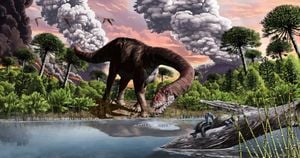The battle for survival is on for the Maugean skate, a rare fish native to Macquarie Harbour, Tasmania. With only 40 to 120 adult skates estimated to be left, conservationists are sounding alarms about the industry's impact on this vulnerable species.
Fresh scientific evaluations recommend strict reductions, or even the complete removal of salmon farming operations from the harbour. According to experts, these farms pose a significant "catastrophic risk" to the Maugean skate's survival.
Evidence suggests the Maugean skate population, projected to decrease by 25% over the next generation, is facing its most critical threat yet. It’s believed the salmon farming industry has led to declining water quality, making habitat increasingly hostile for this ancient ray-like species.
Environment Minister Tanya Plibersek responded to these concerns by initiating a review of salmon farming practices, following demands by conservation groups. Earlier advice had already suggested urgent destocking of salmon—a measure to help save the endangered skate.
Greens Senator Peter Whish-Wilson expressed frustration, questioning how many more warnings are needed before significant actions are taken. He emphasized the need for timely intervention as scientists have raised the alarm repeatedly.
Historically, the salmon industry has thrived since the late 1980s, reaching peak operations of 20,000 tonnes by 2014. Supporters argue about the importance of the industry to local economies, warning against hasty decisions to abandon these practices.
Salmon Tasmania, which represents major aquaculture players, believes the industry can coexist with the Maugean skate. They question the feasibility of simply stopping salmon farming, highlighting the broader environmental pressures also at play, like climate change.
With tensions rising, local workers plan to visit Canberra to stress the significance of salmon farming for their livelihoods. They urge the government to assess not only environmental concerns but also economic repercussions for communities tied to this industry.
Public debate grows fraught, as opinions divide sharply across different community groups and political entities. The response from the government remains cautious, with officials stating the need for thorough assessment of all evidence.
Earlier this year, captive breeding programs were launched, with recent hatchings from eggs laid under controlled conditions. Hope flickers as these preservation efforts aim to bolster the dwindling population of Maugean skates.
Alongside the breeding efforts, initiatives worth $7.2 million are aimed at restoring oxygen levels in the harbour’s waters. This critical measure is described as merely one piece of the puzzle, with experts warning it alone cannot resolve the looming threats to the skate’s habitat.
The threatened species committee aims to gather public feedback to potentially upgrade the Maugean skate’s classification from endangered to critically endangered. This decision is anticipated as the reconsideration of salmon farm licenses proceeds.
Local opposition, including anti-salmon groups, demand immediate action to dismantle salmon farming operations from the harbour. They argue for urgency, insisting there should be no more delays as the survival of the Maugean skate hangs in the balance.
Scientists cite existing problems, such as poor water quality due to diminished oxygen levels, as primary reasons for the skate’s plight. The committee emphasizes the necessity to decrease salmon farming to remediate water conditions and protect this species.
Future plans include improving water quality management through systematic alterations to upstream river flows and mechanical enhancements for dissolved oxygen levels. Conservationists maintain these actions are imperative to curb the existential threats to the Maugean skate.
Anecdotal observations reflect frustration from various stakeholders, ranging from environmentalists to industry supporters, about the lack of decisive government action. The push to balance ecological health with economic viability continues alongside discussions about the community’s future.
The situation remains dynamic, as all eyes turn to the government’s decision-making process. The fate of the Maugean skate and its once-abundant habitat now rests on how swiftly and effectively these challenges are addressed.



